How to correctly determine the distance from the gas tank to the apartment building: choose a suitable place on the site
The use of "blue fuel" for domestic needs has a significant drawback - the difficulty in the implementation of delivery and storage. This shortcoming was overcome thanks to the gas tank - the "vat" for hydrocarbon liquefied gas.
Arrangement of autonomous gasification is subject to a set of requirements and standards. First of all, it is necessary to evaluate the parameters of the site, to determine the distance from the gas tank to the apartment building, the nearest buildings and communications.
The content of the article:
Site assessment: installation of a gas tank
The main gasification of remote villages is not yet completed, and many settlements are left without convenient "blue fuel". An alternative solution for centralized gas supply is the installation of a gas tank and the arrangement of an autonomous network.
A gas holder is a monolithic container for storing natural gas. Structurally, the tank is made in the form of a tank with a neck. In the upper part there are elements that control the pressure and remaining fuel.
Undoubtedly, the operation of any gas equipment carries a certain risk, therefore, organization autonomous gasification, a number of requirements are presented to the location and installation technology of the gas tank.
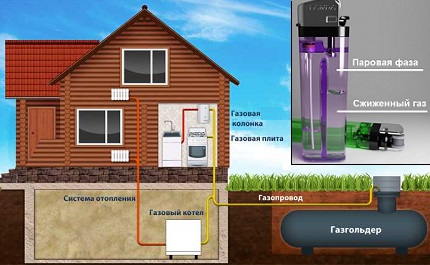
The gas storage installation site is evaluated according to the following criteria:
- relief;
- the composition of the underlying and surrounding ground layers and the proximity of groundwater;
- the presence of water points, residential, utility and public premises.
Relief. The area selected for surface mounting should be flat. This requirement is especially true when installing ground-based modifications - installation on a slope is prohibited.
Priming. It is permissible to place a gas storage in soil massifs with different moisture contents. The physical and mechanical properties of the rocks will determine the convenience of land work and the choice of type of gas tank.
If there is no risk of valve flooding, models without a high neck can be used. As an option, a tank is suitable where the bends are attached to the welded nozzles 12 cm long - this "safety" height, if there is any doubt about the flooding.
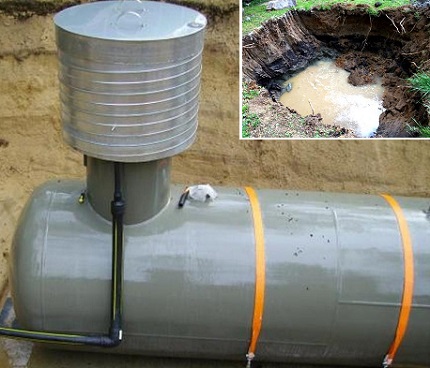
Water is an excellent conductor of heat waves, and the process of evaporation of a propane-butane mixture determines the temperature of the medium. The higher the indicator, the more intense the process. Installation work in low-moisture rocks is simpler, but the environment for the normal operation of the gas tank is less favorable.
Coarse-grained soil can be dangerous, especially if its components are poorly rounded, i.e. with sharp edges. Boulders, pebbles and large rubble complicate the installation of equipment, and the mass of gravel and wood makes an additional load on the gas pipeline.
In most cases, for installation selected gas tank a foundation pit is being developed, which is recommended to be filled with river or quarry sand after immersion of the structure.
Proximity to water intake. According to construction standards, the minimum distance from the gas tank to the reservoir (well, well) is 15 m, to the water main - 5 m.
Neighborhood with buildings. Fire distances from liquefied gas tanks to structures are indicated in clause 8.1.6 of the gas distribution systems normative document (SNiP 42-01-2002). The following section is devoted to this issue.
It is more practical to place the gas holder closer to the gate for an unhindered entrance of the gas carrier and to refuel the tank.
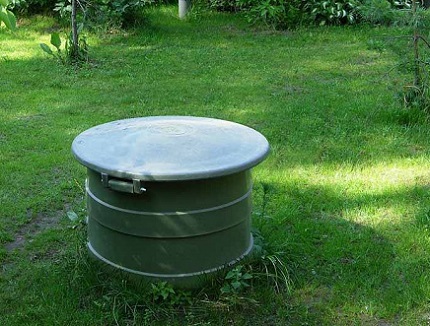
In addition, concreting or paving of the site is unacceptable, as well as the organization of a parking space and tree planting.
Fire distances to objects to be protected
Determining the optimal location for gas tank installations on the site depends on the volume of the tank and the method of its installation: underground or ground installation. For each option, strict standards are defined, the neglect of which is unacceptable according to explosive, environmental and fire safety requirements.
Volume - the determining parameter of the remoteness of buildings
On the correct choice of volume depends not only the location of the tank on the site, but also ease of use. The volume of the gas holder is selected so that one refueling is enough for 1-1.5 years. Volume calculation is based on the area of the house.
According to the standards, 20 liters of “blue fuel” are consumed per year for heating 1 square meter of housing. If the gas is used in parallel for cooking, hot water, the rate increases to 27 l / year.
Knowing the dimensions of the house and the needs of residents, it is easy to carry out the calculation. For example, for a cottage of 200 square meters, a gas tank with a volume of 4000 liters is suitable. An alternative is to determine the size of the tank by the power of the boiler plant. For example, for a 50 W boiler, a 5,000 liter gas holder is required.
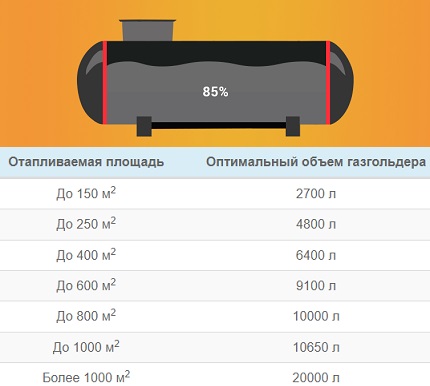
Norms of location of underground gas tanks
For year-round operation in cold winters, you must choose an underground "storage". The module plunges below the freezing line of the soil, which supports the natural evaporation of gas at sub-zero outside temperatures.
General standards for distance from underground tanks of any volume:
- sports grounds, children's complexes, garages - 10 m;
- underground pipeline of heating main, sewerage - 3.5 m;
- external communications not included in the backup equipment group - 5 m;
- edge of the carriageway of the non-high-speed road for 1-2 lanes - 5 m;
- motorways and express roads for 3 or more lanes - 10 m;
- access tram track, railways of industrial importance - 10 m.
The distance to buildings for various purposes is determined by the capacity of the tank for liquefied gas. Gradation of values is provided for “storages” of up to 10 cubic meters, 10-20 cubic meters, 20-50 cubic meters.

Various standards are provided for installation of a private "gas storage" regarding production facilities. The range of distances is 8-15 m. The distance to general-purpose railways is also regulated - 20-30 m, depending on the volume of the gas tank.
SNiP allows a 50% reduction in the interval between a residential building and a "gas vat". However, such a decision must be justified by technical reasons and agreed upon at the local gas distribution system unit.
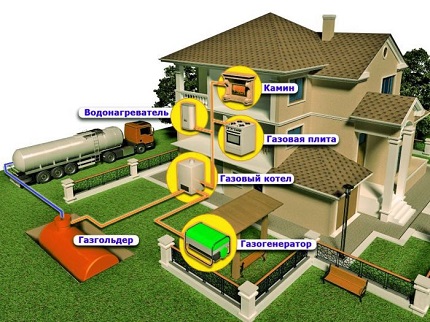
In addition to the requirements for the remoteness of the gas tank from different objects, a list of rules for adjusting the underground "storage" is provided:
- installation depth - at least 60 cm from the upper wall of the tank to the soil surface;
- distance between underground gas tanks - at least 1 m;
- the neck and fittings of the tank must be freely accessible.
Regardless of the displacement, the underground tank is mounted on a foundation - a concrete slab. The base prevents the reservoir from “floating up” in the event of soil movements.
Subtleties of mounting a ground tank
The use of a ground gas tank has several significant advantages: simplicity, installation speed, and a decrease in the intensity of metal corrosion. Local damage is easy to detect and repair in a timely manner.
However, this type of equipment is rarely used for gas supply to a private house. The main reason is a significant decrease in system performance in winter. At sub-zero temperatures (below -0.5 ° C), liquefied gas does not evaporate naturally.
To support the process, a gas tank must be equipped with an evaporator. With a low consumption of “blue fuel”, capital investments in gasification pay off for a very long time. Due to the ground location, the requirements for fire distances from the gas storage to buildings and other facilities are more stringent.
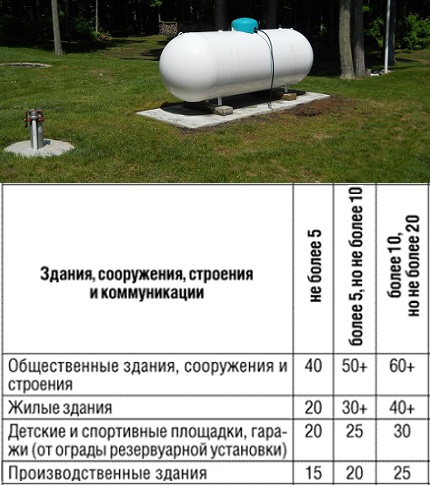
Additional restrictions on the location of the ground "gas vat":
- general-purpose railways - 25-30-40 m in accordance with the volume;
- local tram and railway lines - 20 m;
- roads of IV-V category (1-2 lanes) - 10 m, I-III category (from 3 lanes) - 20 m.
For safety reasons, a kind of open hood is being arranged over the gas tank, protecting the module from direct sunlight and precipitation. Overheating of the tank or lightning can cause an explosion, and rain and snow can lead to accelerated corrosion.
Placement of mobile gas storages
The mini-gas tank is a capacious gas cylinder with a volume of up to 500 cubic meters, equipped with the valves required for safe operation: a gearbox, a level gauge and safety valves.The equipment is compact in size, for example, the parameters of a tank of 480 l are: length - 2 m, diameter - 60 cm.
When used correctly mini format gas holders its service life is the same as that of a full-sized gas tank. The mini-model is stationary or mounted on a caravan, which ensures mobility of the gas storage.
Gas station mobile capacity greatly simplified, as it becomes possible both at the location and at the gas station.
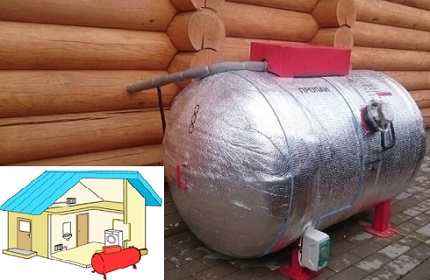
According to SP 63.13330 of 2011, the minimum distance from the house to a small gas tank is permissible, namely the placement directly against the wall. Remoteness of equipment from other objects of protection is not specified.
Mini-gas holders are in demand to provide autonomous gasification of rooms with a relatively small or seasonal fuel consumption: country houses, heating of cafe sites, and a hotel. The reservoir is often used as a backup source of gas in case of interruptions from the central gas main.
Set of requirements for laying a gas pipeline
Certain standardized standards are also presented for the arrangement of the gas pipeline going from the gas tank to the house. Gas is supplied to the room via an underground highway through the basement. Safety rules prohibit the entry of a gas pipeline into a house underground.

General requirements for laying a gas pipeline on the gas holder-house section:
- track depth - not less than 1.7 m;
- the width of the trench - there are no strict restrictions, the size depends on the meter of the gas pipeline and the quality of the soil;
- the minimum slope towards the condensate collector is 1 cm per 1 m (not more than 5 °), the maximum deviation is 100 mm;
- distance from the highway to the foundations of buildings - 2 m or more;
- the distance to the parallel communications is 1 m, with a cross arrangement - 2 m in height.
The underground gas line is mounted from high density polyethylene pipes with a nitrile content. Ground highway - steel gas pipes. The polymer pipeline should not reach the point where the temperature of the soil drops to -20 ° C or less.
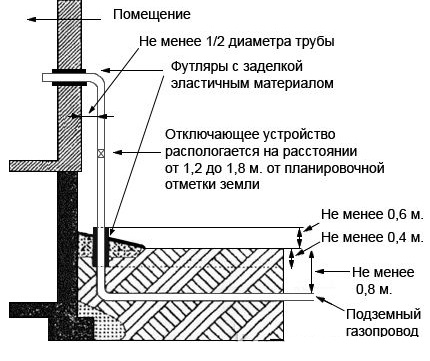
Gas tank operating safety
Despite all the advantages of autonomous gasification, many consumers are frightened by the idea of the risks of storing flammable substances in the area near the apartment building.
To ensure safety, it is not enough to maintain the required distances during installation; all conditions for refueling, operation and maintenance of the gas holder installation must be observed.
Operating Rules:
- Inexhaustible reserve conservation - about ¼ of the volume. When using all the fuel in the tank, a vacuum is formed, with further refueling in violation of the technology, an explosion is possible.
- Filling a gas tank with an exclusively specialized company. Insignificant savings on the services of unskilled "gas workers" can lead to a fire.
- Safety valve operation monitoring. Timely troubleshooting will prevent an emergency.
- Prevent gas leakage. The outflow of “blue fuel” is the most dangerous - the propane-butane mixture “spreads” downward, since it is heavier than air.
The probability of fuel leakage occurs if the tank is damaged, valves fail, unqualified repair or refueling, and also when the elements of the gas distribution system are leaky.
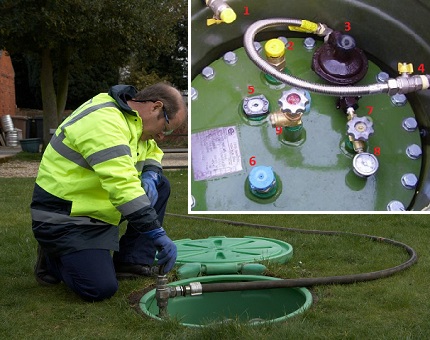
Mandatory precautions include the use of lightning protection and grounding. Near the gas tank it is unacceptable to conduct welding work, kindling a fire.
With standard rates for the installation of the gas tank will introduce next article, in which all items of upcoming expenses are analyzed in detail and recommendations are given on possible savings.
Conclusions and useful video on the topic
Video report on the work of the installed gas tank for servicing a private house. The review deals with the equipment snap-in ensuring safety of use, and the permissible distances to objects on the site:
One of the main requirements for the safe operation of the gas tank is to comply with the normalized distances from the apartment building and other facilities to the gas storage. Under unsatisfied conditions of the site itself, some indulgence with respect to boundary distances is permissible. Assessment of the installation site and installation is best entrusted to a specialized company.
Tell us about how you selected a place on a personal site for installing a gas tank. It is possible that you have useful information that is useful to site visitors. Please write comments in the block below, post a photo on the topic of the article, ask questions.

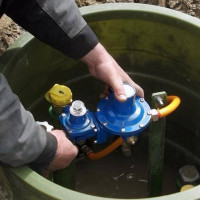 Pressure reducer for gas tank: operating principle, design features and replacement instruction
Pressure reducer for gas tank: operating principle, design features and replacement instruction 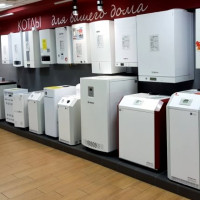 TOP-10 non-volatile gas boilers for heating a private house: a review of models + selection rules
TOP-10 non-volatile gas boilers for heating a private house: a review of models + selection rules 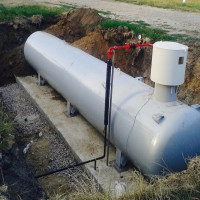 Gas heating with a gas tank - is it worth it? Overview of all the nuances, advantages and disadvantages of such a solution
Gas heating with a gas tank - is it worth it? Overview of all the nuances, advantages and disadvantages of such a solution 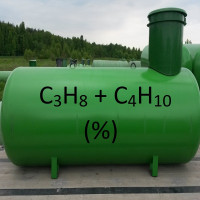 Winter and summer gas - what is the difference? Which gas is better to use for refueling gas tanks
Winter and summer gas - what is the difference? Which gas is better to use for refueling gas tanks 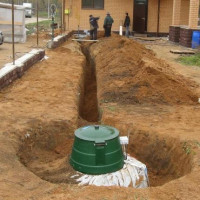 Gas tank Antonio Merloni (Antonio Merloni): lineup and equipment selection criteria
Gas tank Antonio Merloni (Antonio Merloni): lineup and equipment selection criteria  Varieties of gas holders: the basics of classification + an overview of popular brands
Varieties of gas holders: the basics of classification + an overview of popular brands  How much does it cost to connect gas to a private house: the price of organizing gas supply
How much does it cost to connect gas to a private house: the price of organizing gas supply  The best washing machines with dryer: model rating and customer tips
The best washing machines with dryer: model rating and customer tips  What is the color temperature of light and the nuances of choosing the temperature of the lamps to suit your needs
What is the color temperature of light and the nuances of choosing the temperature of the lamps to suit your needs  Replacement of a geyser in an apartment: replacement paperwork + basic norms and requirements
Replacement of a geyser in an apartment: replacement paperwork + basic norms and requirements
I worked for several years in a company engaged in autonomous gasification. The distance of underground gas tanks to residential buildings in practice almost never meets the established requirements. As a rule, the plots are small, and people want to save the space occupied by the gas tank. Sometimes there is simply no way to mark it, except at the house itself. The fact is that in Russia Rostekhnadzor is controlled only by legal entities. Citizens and their homes for violations of the law regarding violations of the joint venture and other regulatory documents no one checks. That's all at your own peril and risk violate these standards. In fairness, I’ll add that in Europe, for example, the distances established by law are much shorter, and even if the equipment is of high quality and installed by competent specialists, any risks are minimal.
I just can’t understand the feasibility of this event ... So I considered the gas consumption for my home, I have electricity (the most expensive resource) it turns out to heat as much for money (in winter), as well as buried gas. But still, what a tremendous work needs to be done to equip a gas tank, a project to do for home wiring too.
Indentation is also not so simple: you will retreat from your house, but you will find yourself at the neighbor's.In old garden societies, plots are small. And they cut new ones in bread places, there is gasification there.
I don’t know how you calculated that to heat with electricity is equal to the price of gas from a gas tank. This is not true. Of course, it comes out more expensive than main gas, but much cheaper than electricity. The main problem is that the gas holder will have to decently spend money and run for permissions initially.
“Run for permissions.” What permissions?